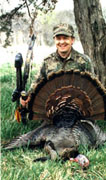How To Make Turkeys Gobble
Copyright © 1998 -
20021
Roger W. Raisch * Nadine Adele, all rights reserved
|
NEWS FLASH....it won't always work.
Further....if he does gobble, don't make him do it too often. You just want him to gobble enough so
you know where he is so you can set up and begin your seductive hen calls. Granted, it's fun to hear him gobble and gobble, but when you make
him gobble over and over, he's likely to attract other hunters to your area...and even
worse, he'll attract a real hen to his location. In both cases, you lose.
|
Despite
your best efforts, and a pocket full of different callers (crow, owl, coyote, peacock,
pileated woodpecker, hawk, etc., etc.,) sometimes you just can't make a turkey
gobble. For example, windy, stormy and moderate-to-heavy rainy days are poor days to
make turkeys gobble. They just aren't in the mood. On some perfectly sunny,
calm and beautiful days you'll not get a response too. To give you some perspective,
I've heard that even in heaven, turkeys don't gobble every day! Get the point?
|
Regardless
of the situation, you should try to get a tom to sound off so you can move into position
on him. I have standard routines
that I try during various times of the day to make a tom "shock gobble".
|
|
Before
Sunrise
|
Assuming I have not roosted a turkey the night before and don't know where
one is, I start my early morning march into the woods so that I
arrive at my first listening post about one hour before sunrise. That is 30 minutes before legal shooting time. I sneak into
position on a high ridge where I can hear well, unless the conditions are windy. In
windy conditions, I find an out-of-the-wind location that is within 200 yards of where I
expect turkeys to be roosted. I start my calling with one loud barred owl hooting
from a Commercial Owl Hooter
(who-cooks-for-you, who-cooks-for-you-all cadence). If nothing answers I
wait about a minute and do it again. Sometimes the first sound gets a gobbler's
attention and the second makes him respond. If you hear a tom gobble a long way off,
don't rush towards him yet. Try a few more hoots to make sure you can't get a bird
to answer that is much closer.
|
Let's assume there is no answer to the owl hooting after about 15
minutes. Now it's about 15 minutes before shooting time and it's getting
light. Now's the time to try a Coyote Howl. My experiences convince me that toms will often respond to the howling of
a coyote above all else at this time. Try a couple of
howls. If that doesn't work, go home. Seriously, now's the time to break out
the Crow Call
and start making a few short bursts of three to six notes and listen for a response.
Wait a few minutes and try the call of a peacock, followed by a pileated woodpecker. Last, try shouting the words "GOBBLE" as loud as you can.
NO.....Don't do that, but I've made turkeys gobble to my yelling, but I don't recommend
it...it sort of kills the drama. If none of this makes
a turkey gobble, move to another location and try again. Note: I do not recommend that you try a gobble tube at this time of the day
because you may end up being the only "gobbler" making noise in the woods which
may attract other hunters, plus if you can't make a tom gobble to all the noise you've
just made, chances are a gobble won't do the trick either.
|
Sunrise To Noon
|
During the morning, after the intense gobbling at sunrise has ceased,
position yourself on a high ridge or other good listening spot and try hooting like an owl
loudly one time only. If no answer, wait about a minute and try it again. If
that fails, blow a short series of loud raspy crow "caws" consisting of about
3-5 notes. Listen for an answer and repeat the call a time or two every two minutes
or so. If you still get no answer, then make a shrill, loud call of a peacock a
couple of times over a period of a couple of minutes, followed by a few spaced out calls
of a pileated woodpecker. If none of this gets an
answer, then let everything quiet down for about 5 minutes and then let out a short, loud
cackle with your turkey call. Try it again but this
time throw in a string of cutts. When you start this hen calling, be prepared to
hear a gobble close, so be ready to sit down quickly next to a suitable tree. If
none of this works, try it again in another strategically located observation spot, but
move to that spot under cover and out of sight of where you think turkeys might be. If you fail to get a turkey to gobble, move into a good Strut Zone
and do patient turkey calling for at least an hour before
moving on to another spot.
|
At Roost Time
|
|
Try a very systematic approach to making a tom gobble on roost in the
evening. First you need to understand that turkeys go
to roost within a few minutes of sundown, by your watch. On overcast, cloudy, or
rainy days they will go to roost up to 30 minutes before sundown. Be in the expected
roost area in full camo at least one hour before roost time. About 10 minutes after
roost time, make a snappy, short hen Cackle which imitates a hen flying up. Combining this with
authentic-sounding wing flapping noises helps to complete the deception. If that
fails to get a response, wait about five minutes and start owl hooting about every
minute. Vary the volume, but occasionally really let
one go at high volume. Often a gobbler will respond to
that extra loud sound. Wait another couple of minutes and make one loud Gobble with your
Gobble Tube.
This is the time when the tube usually works if it's going to. Wait another couple of
minutes and make a coyote howl or two if a bird doesn't answer. If none of this
works, quickly move to another good listening post at least 1/4 mile away from where you
were and repeat the process. If you strike out at the second spot, you'll go home
thinking you don't know a darned thing about roosting turkeys.
|
The truth is no matter how good your locator calling is, there are many
times when no sound will make a turkey gobble. My
success in making a turkey gobble when I want him to is no better than 50%. |
| |
t

God Bless America
|
View
Cart & Check-Out
NOVEMBER
2025
877.267.3877
515.299.5388
24 / 7
WE answer
our
phones Personally!
|
|












